Applied Business Finance: Financial Analysis and Improvement
VerifiedAdded on 2023/06/13
|12
|2718
|76
Report
AI Summary
This report provides a comprehensive financial analysis of a sample organization, focusing on key aspects of financial management, including financial statement analysis and performance improvement. It begins with an introduction to financial management, highlighting its importance in planning, organizing, and controlling financial activities. The report then discusses the main financial statements—balance sheet, income statement, and cash flow statement—and explains the use of ratios in financial management to assess a company's performance relative to its competitors. A business review template is completed, including an income statement and balance sheet for the sample organization. The analysis covers profitability, liquidity, and efficiency, using ratios such as gross profit margin, net profit margin, current ratio, quick ratio, and asset turnover ratio. The report concludes by discussing processes that businesses can use to improve their financial performance, such as reducing overhead costs and improving accounts receivable collection.
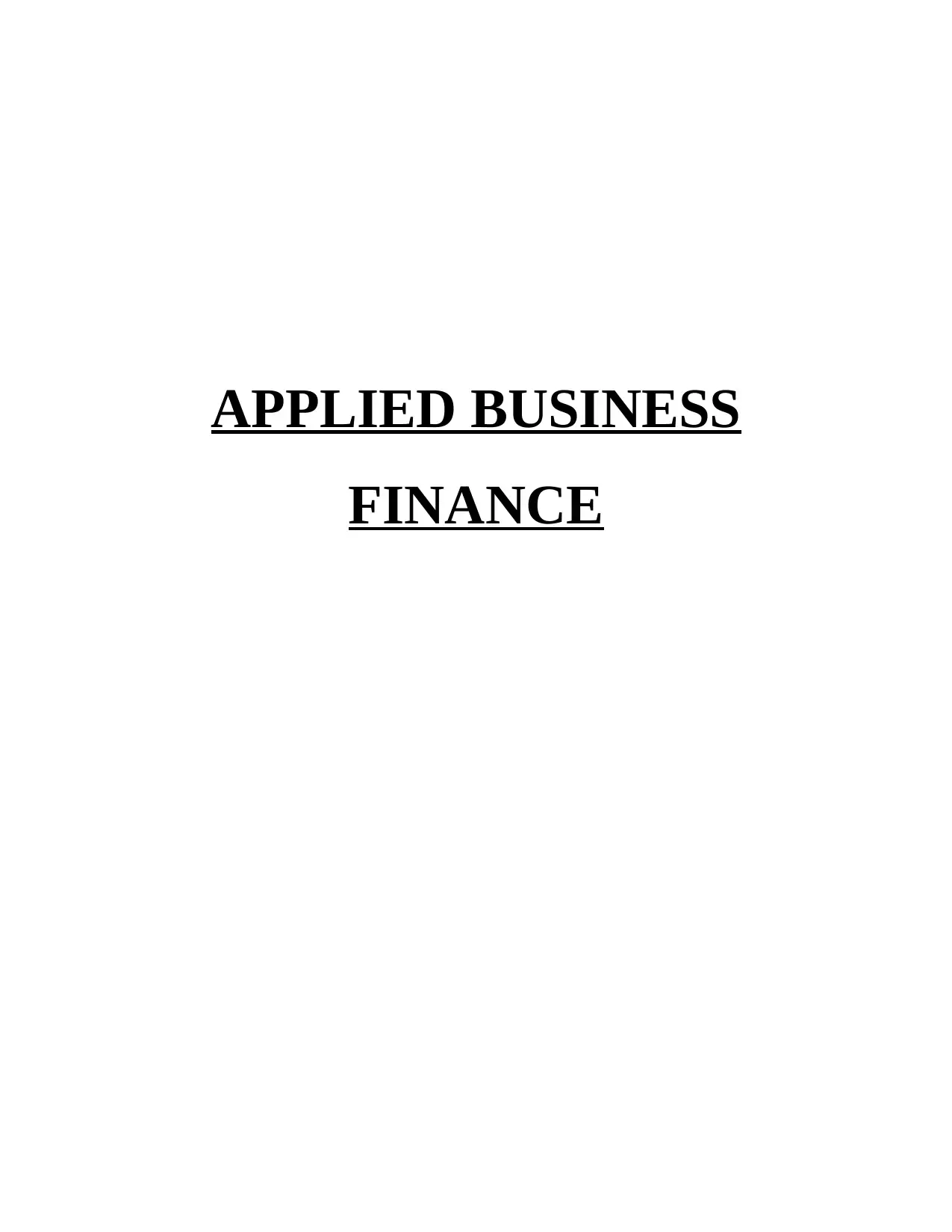
APPLIED BUSINESS
FINANCE
FINANCE
Paraphrase This Document
Need a fresh take? Get an instant paraphrase of this document with our AI Paraphraser
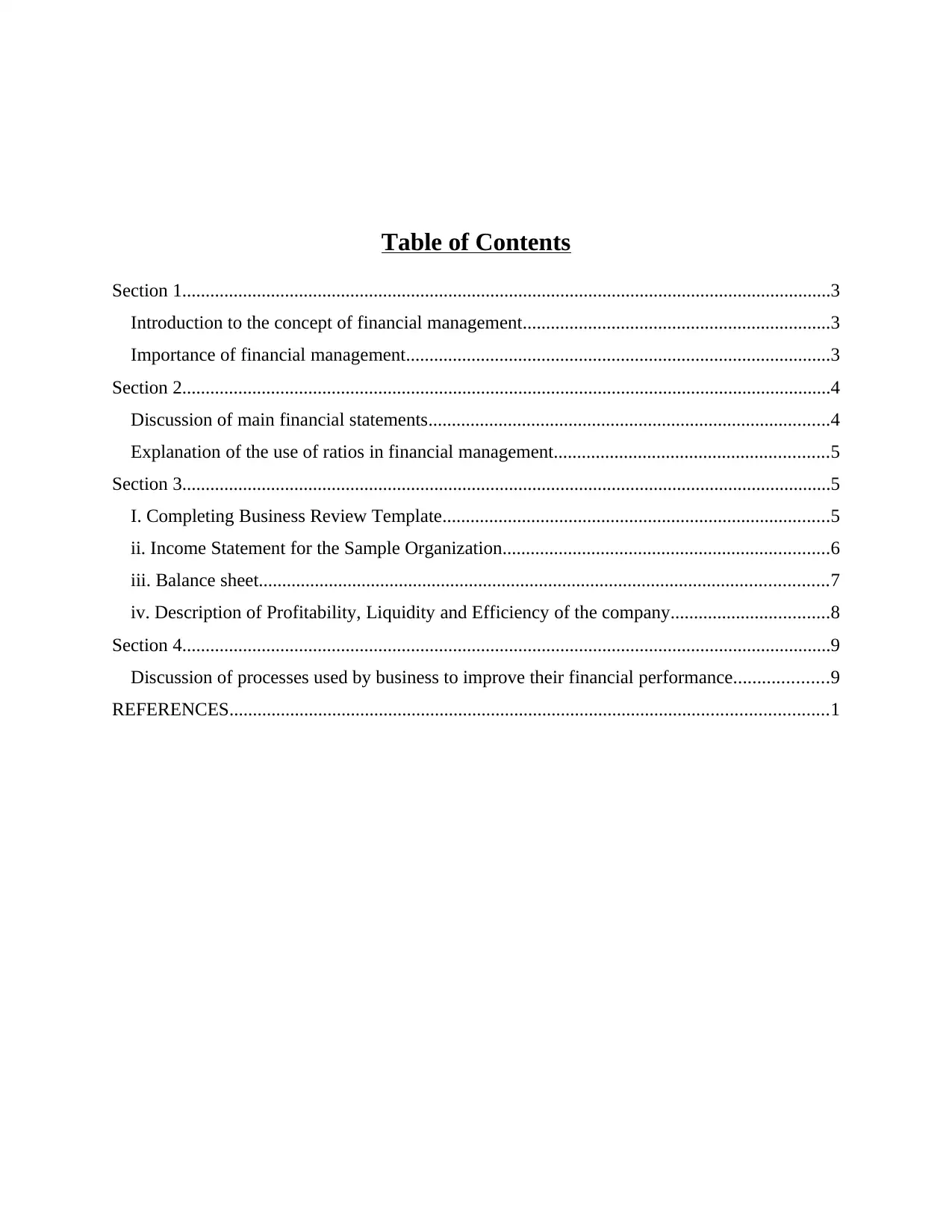
Table of Contents
Section 1...........................................................................................................................................3
Introduction to the concept of financial management..................................................................3
Importance of financial management...........................................................................................3
Section 2...........................................................................................................................................4
Discussion of main financial statements......................................................................................4
Explanation of the use of ratios in financial management...........................................................5
Section 3...........................................................................................................................................5
I. Completing Business Review Template...................................................................................5
ii. Income Statement for the Sample Organization......................................................................6
iii. Balance sheet..........................................................................................................................7
iv. Description of Profitability, Liquidity and Efficiency of the company..................................8
Section 4...........................................................................................................................................9
Discussion of processes used by business to improve their financial performance....................9
REFERENCES................................................................................................................................1
Section 1...........................................................................................................................................3
Introduction to the concept of financial management..................................................................3
Importance of financial management...........................................................................................3
Section 2...........................................................................................................................................4
Discussion of main financial statements......................................................................................4
Explanation of the use of ratios in financial management...........................................................5
Section 3...........................................................................................................................................5
I. Completing Business Review Template...................................................................................5
ii. Income Statement for the Sample Organization......................................................................6
iii. Balance sheet..........................................................................................................................7
iv. Description of Profitability, Liquidity and Efficiency of the company..................................8
Section 4...........................................................................................................................................9
Discussion of processes used by business to improve their financial performance....................9
REFERENCES................................................................................................................................1
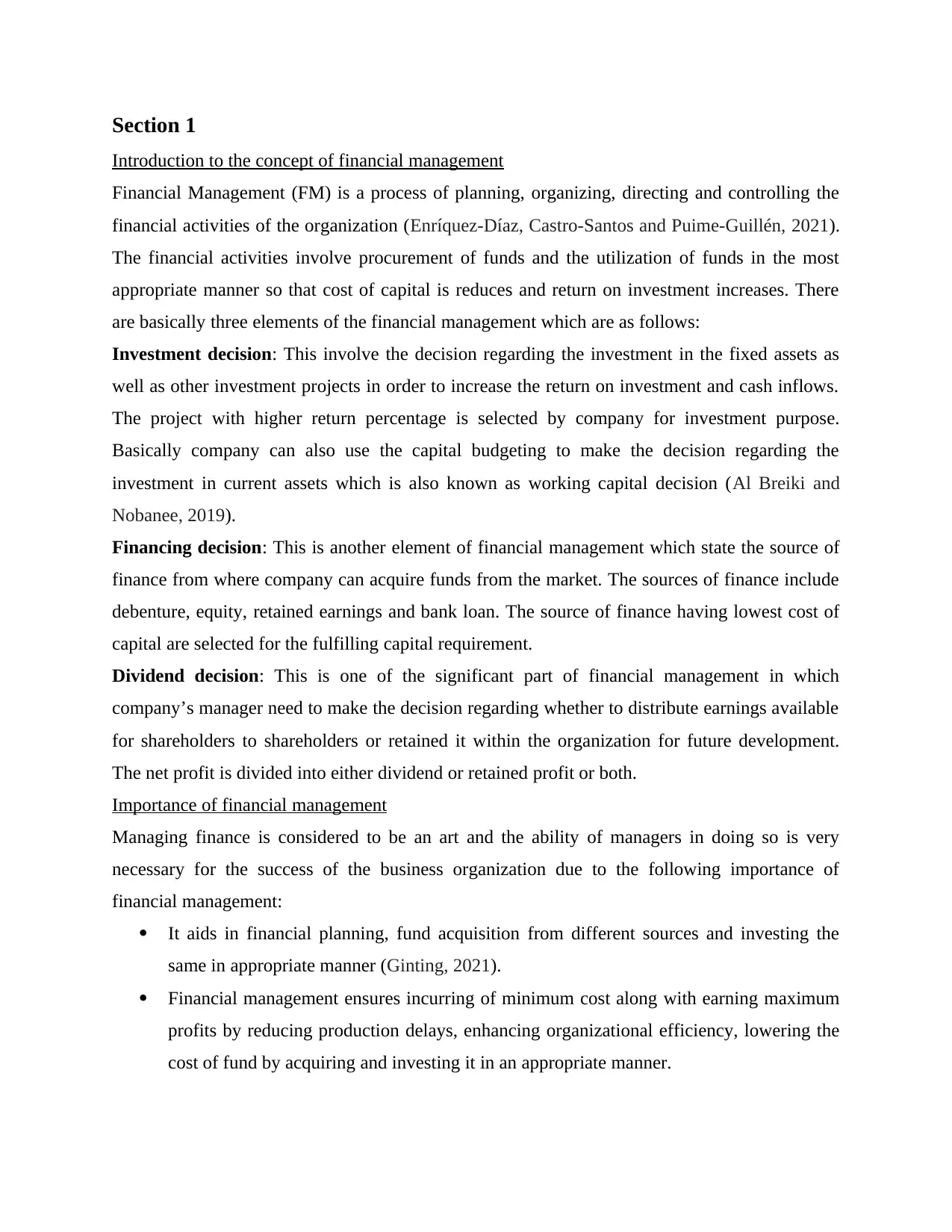
Section 1
Introduction to the concept of financial management
Financial Management (FM) is a process of planning, organizing, directing and controlling the
financial activities of the organization (Enríquez-Díaz, Castro-Santos and Puime-Guillén, 2021).
The financial activities involve procurement of funds and the utilization of funds in the most
appropriate manner so that cost of capital is reduces and return on investment increases. There
are basically three elements of the financial management which are as follows:
Investment decision: This involve the decision regarding the investment in the fixed assets as
well as other investment projects in order to increase the return on investment and cash inflows.
The project with higher return percentage is selected by company for investment purpose.
Basically company can also use the capital budgeting to make the decision regarding the
investment in current assets which is also known as working capital decision (Al Breiki and
Nobanee, 2019).
Financing decision: This is another element of financial management which state the source of
finance from where company can acquire funds from the market. The sources of finance include
debenture, equity, retained earnings and bank loan. The source of finance having lowest cost of
capital are selected for the fulfilling capital requirement.
Dividend decision: This is one of the significant part of financial management in which
company’s manager need to make the decision regarding whether to distribute earnings available
for shareholders to shareholders or retained it within the organization for future development.
The net profit is divided into either dividend or retained profit or both.
Importance of financial management
Managing finance is considered to be an art and the ability of managers in doing so is very
necessary for the success of the business organization due to the following importance of
financial management:
It aids in financial planning, fund acquisition from different sources and investing the
same in appropriate manner (Ginting, 2021).
Financial management ensures incurring of minimum cost along with earning maximum
profits by reducing production delays, enhancing organizational efficiency, lowering the
cost of fund by acquiring and investing it in an appropriate manner.
Introduction to the concept of financial management
Financial Management (FM) is a process of planning, organizing, directing and controlling the
financial activities of the organization (Enríquez-Díaz, Castro-Santos and Puime-Guillén, 2021).
The financial activities involve procurement of funds and the utilization of funds in the most
appropriate manner so that cost of capital is reduces and return on investment increases. There
are basically three elements of the financial management which are as follows:
Investment decision: This involve the decision regarding the investment in the fixed assets as
well as other investment projects in order to increase the return on investment and cash inflows.
The project with higher return percentage is selected by company for investment purpose.
Basically company can also use the capital budgeting to make the decision regarding the
investment in current assets which is also known as working capital decision (Al Breiki and
Nobanee, 2019).
Financing decision: This is another element of financial management which state the source of
finance from where company can acquire funds from the market. The sources of finance include
debenture, equity, retained earnings and bank loan. The source of finance having lowest cost of
capital are selected for the fulfilling capital requirement.
Dividend decision: This is one of the significant part of financial management in which
company’s manager need to make the decision regarding whether to distribute earnings available
for shareholders to shareholders or retained it within the organization for future development.
The net profit is divided into either dividend or retained profit or both.
Importance of financial management
Managing finance is considered to be an art and the ability of managers in doing so is very
necessary for the success of the business organization due to the following importance of
financial management:
It aids in financial planning, fund acquisition from different sources and investing the
same in appropriate manner (Ginting, 2021).
Financial management ensures incurring of minimum cost along with earning maximum
profits by reducing production delays, enhancing organizational efficiency, lowering the
cost of fund by acquiring and investing it in an appropriate manner.
⊘ This is a preview!⊘
Do you want full access?
Subscribe today to unlock all pages.

Trusted by 1+ million students worldwide
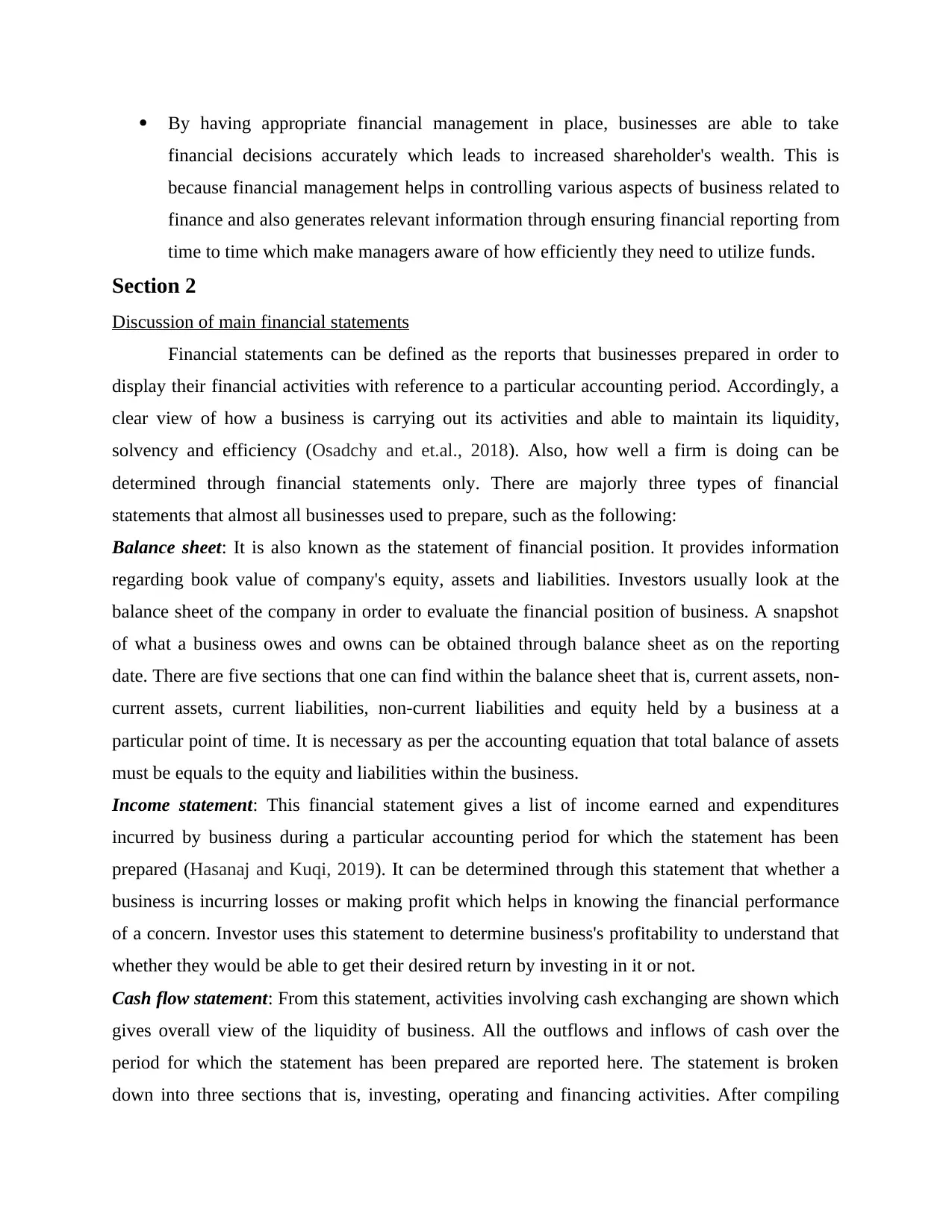
By having appropriate financial management in place, businesses are able to take
financial decisions accurately which leads to increased shareholder's wealth. This is
because financial management helps in controlling various aspects of business related to
finance and also generates relevant information through ensuring financial reporting from
time to time which make managers aware of how efficiently they need to utilize funds.
Section 2
Discussion of main financial statements
Financial statements can be defined as the reports that businesses prepared in order to
display their financial activities with reference to a particular accounting period. Accordingly, a
clear view of how a business is carrying out its activities and able to maintain its liquidity,
solvency and efficiency (Osadchy and et.al., 2018). Also, how well a firm is doing can be
determined through financial statements only. There are majorly three types of financial
statements that almost all businesses used to prepare, such as the following:
Balance sheet: It is also known as the statement of financial position. It provides information
regarding book value of company's equity, assets and liabilities. Investors usually look at the
balance sheet of the company in order to evaluate the financial position of business. A snapshot
of what a business owes and owns can be obtained through balance sheet as on the reporting
date. There are five sections that one can find within the balance sheet that is, current assets, non-
current assets, current liabilities, non-current liabilities and equity held by a business at a
particular point of time. It is necessary as per the accounting equation that total balance of assets
must be equals to the equity and liabilities within the business.
Income statement: This financial statement gives a list of income earned and expenditures
incurred by business during a particular accounting period for which the statement has been
prepared (Hasanaj and Kuqi, 2019). It can be determined through this statement that whether a
business is incurring losses or making profit which helps in knowing the financial performance
of a concern. Investor uses this statement to determine business's profitability to understand that
whether they would be able to get their desired return by investing in it or not.
Cash flow statement: From this statement, activities involving cash exchanging are shown which
gives overall view of the liquidity of business. All the outflows and inflows of cash over the
period for which the statement has been prepared are reported here. The statement is broken
down into three sections that is, investing, operating and financing activities. After compiling
financial decisions accurately which leads to increased shareholder's wealth. This is
because financial management helps in controlling various aspects of business related to
finance and also generates relevant information through ensuring financial reporting from
time to time which make managers aware of how efficiently they need to utilize funds.
Section 2
Discussion of main financial statements
Financial statements can be defined as the reports that businesses prepared in order to
display their financial activities with reference to a particular accounting period. Accordingly, a
clear view of how a business is carrying out its activities and able to maintain its liquidity,
solvency and efficiency (Osadchy and et.al., 2018). Also, how well a firm is doing can be
determined through financial statements only. There are majorly three types of financial
statements that almost all businesses used to prepare, such as the following:
Balance sheet: It is also known as the statement of financial position. It provides information
regarding book value of company's equity, assets and liabilities. Investors usually look at the
balance sheet of the company in order to evaluate the financial position of business. A snapshot
of what a business owes and owns can be obtained through balance sheet as on the reporting
date. There are five sections that one can find within the balance sheet that is, current assets, non-
current assets, current liabilities, non-current liabilities and equity held by a business at a
particular point of time. It is necessary as per the accounting equation that total balance of assets
must be equals to the equity and liabilities within the business.
Income statement: This financial statement gives a list of income earned and expenditures
incurred by business during a particular accounting period for which the statement has been
prepared (Hasanaj and Kuqi, 2019). It can be determined through this statement that whether a
business is incurring losses or making profit which helps in knowing the financial performance
of a concern. Investor uses this statement to determine business's profitability to understand that
whether they would be able to get their desired return by investing in it or not.
Cash flow statement: From this statement, activities involving cash exchanging are shown which
gives overall view of the liquidity of business. All the outflows and inflows of cash over the
period for which the statement has been prepared are reported here. The statement is broken
down into three sections that is, investing, operating and financing activities. After compiling
Paraphrase This Document
Need a fresh take? Get an instant paraphrase of this document with our AI Paraphraser
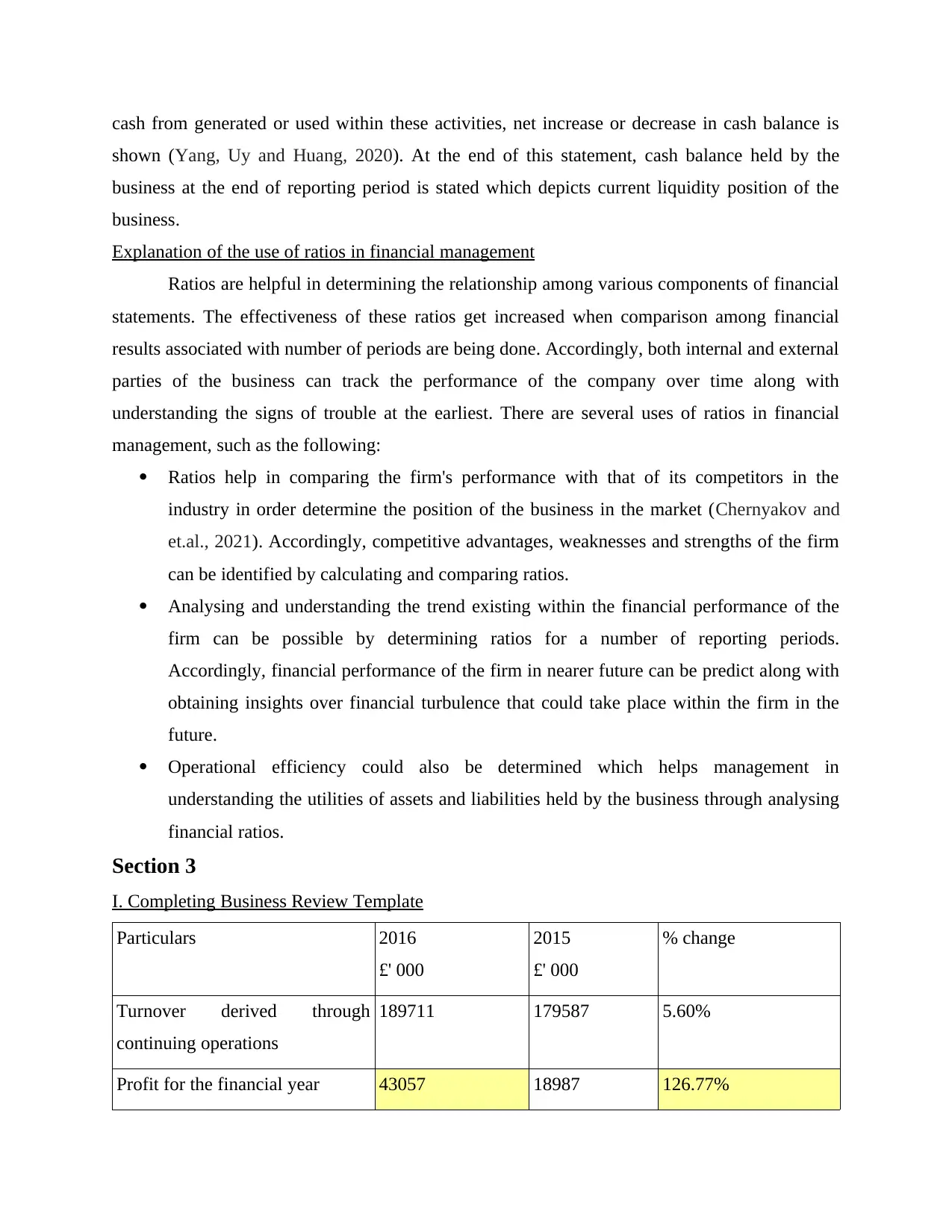
cash from generated or used within these activities, net increase or decrease in cash balance is
shown (Yang, Uy and Huang, 2020). At the end of this statement, cash balance held by the
business at the end of reporting period is stated which depicts current liquidity position of the
business.
Explanation of the use of ratios in financial management
Ratios are helpful in determining the relationship among various components of financial
statements. The effectiveness of these ratios get increased when comparison among financial
results associated with number of periods are being done. Accordingly, both internal and external
parties of the business can track the performance of the company over time along with
understanding the signs of trouble at the earliest. There are several uses of ratios in financial
management, such as the following:
Ratios help in comparing the firm's performance with that of its competitors in the
industry in order determine the position of the business in the market (Chernyakov and
et.al., 2021). Accordingly, competitive advantages, weaknesses and strengths of the firm
can be identified by calculating and comparing ratios.
Analysing and understanding the trend existing within the financial performance of the
firm can be possible by determining ratios for a number of reporting periods.
Accordingly, financial performance of the firm in nearer future can be predict along with
obtaining insights over financial turbulence that could take place within the firm in the
future.
Operational efficiency could also be determined which helps management in
understanding the utilities of assets and liabilities held by the business through analysing
financial ratios.
Section 3
I. Completing Business Review Template
Particulars 2016
£' 000
2015
£' 000
% change
Turnover derived through
continuing operations
189711 179587 5.60%
Profit for the financial year 43057 18987 126.77%
shown (Yang, Uy and Huang, 2020). At the end of this statement, cash balance held by the
business at the end of reporting period is stated which depicts current liquidity position of the
business.
Explanation of the use of ratios in financial management
Ratios are helpful in determining the relationship among various components of financial
statements. The effectiveness of these ratios get increased when comparison among financial
results associated with number of periods are being done. Accordingly, both internal and external
parties of the business can track the performance of the company over time along with
understanding the signs of trouble at the earliest. There are several uses of ratios in financial
management, such as the following:
Ratios help in comparing the firm's performance with that of its competitors in the
industry in order determine the position of the business in the market (Chernyakov and
et.al., 2021). Accordingly, competitive advantages, weaknesses and strengths of the firm
can be identified by calculating and comparing ratios.
Analysing and understanding the trend existing within the financial performance of the
firm can be possible by determining ratios for a number of reporting periods.
Accordingly, financial performance of the firm in nearer future can be predict along with
obtaining insights over financial turbulence that could take place within the firm in the
future.
Operational efficiency could also be determined which helps management in
understanding the utilities of assets and liabilities held by the business through analysing
financial ratios.
Section 3
I. Completing Business Review Template
Particulars 2016
£' 000
2015
£' 000
% change
Turnover derived through
continuing operations
189711 179587 5.60%
Profit for the financial year 43057 18987 126.77%
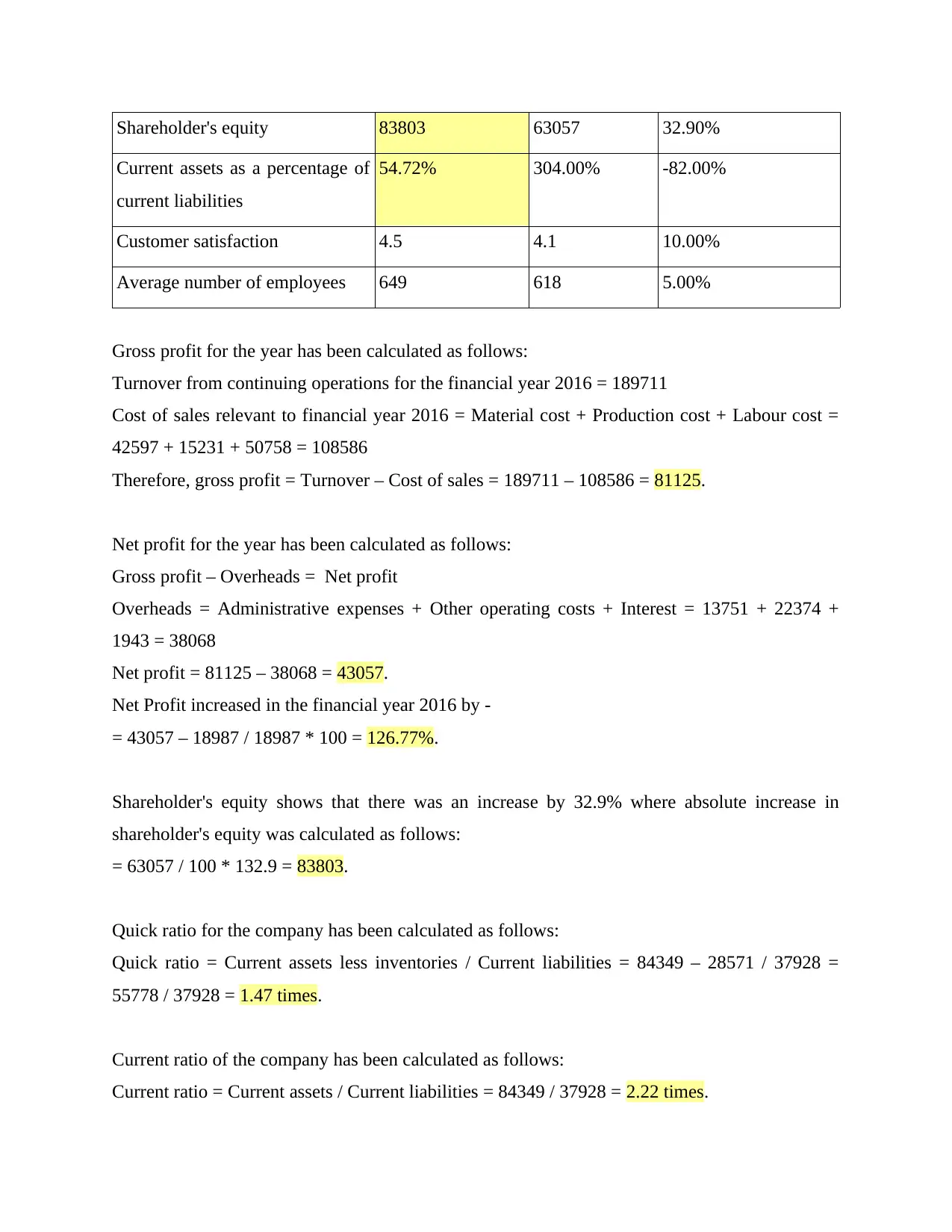
Shareholder's equity 83803 63057 32.90%
Current assets as a percentage of
current liabilities
54.72% 304.00% -82.00%
Customer satisfaction 4.5 4.1 10.00%
Average number of employees 649 618 5.00%
Gross profit for the year has been calculated as follows:
Turnover from continuing operations for the financial year 2016 = 189711
Cost of sales relevant to financial year 2016 = Material cost + Production cost + Labour cost =
42597 + 15231 + 50758 = 108586
Therefore, gross profit = Turnover – Cost of sales = 189711 – 108586 = 81125.
Net profit for the year has been calculated as follows:
Gross profit – Overheads = Net profit
Overheads = Administrative expenses + Other operating costs + Interest = 13751 + 22374 +
1943 = 38068
Net profit = 81125 – 38068 = 43057.
Net Profit increased in the financial year 2016 by -
= 43057 – 18987 / 18987 * 100 = 126.77%.
Shareholder's equity shows that there was an increase by 32.9% where absolute increase in
shareholder's equity was calculated as follows:
= 63057 / 100 * 132.9 = 83803.
Quick ratio for the company has been calculated as follows:
Quick ratio = Current assets less inventories / Current liabilities = 84349 – 28571 / 37928 =
55778 / 37928 = 1.47 times.
Current ratio of the company has been calculated as follows:
Current ratio = Current assets / Current liabilities = 84349 / 37928 = 2.22 times.
Current assets as a percentage of
current liabilities
54.72% 304.00% -82.00%
Customer satisfaction 4.5 4.1 10.00%
Average number of employees 649 618 5.00%
Gross profit for the year has been calculated as follows:
Turnover from continuing operations for the financial year 2016 = 189711
Cost of sales relevant to financial year 2016 = Material cost + Production cost + Labour cost =
42597 + 15231 + 50758 = 108586
Therefore, gross profit = Turnover – Cost of sales = 189711 – 108586 = 81125.
Net profit for the year has been calculated as follows:
Gross profit – Overheads = Net profit
Overheads = Administrative expenses + Other operating costs + Interest = 13751 + 22374 +
1943 = 38068
Net profit = 81125 – 38068 = 43057.
Net Profit increased in the financial year 2016 by -
= 43057 – 18987 / 18987 * 100 = 126.77%.
Shareholder's equity shows that there was an increase by 32.9% where absolute increase in
shareholder's equity was calculated as follows:
= 63057 / 100 * 132.9 = 83803.
Quick ratio for the company has been calculated as follows:
Quick ratio = Current assets less inventories / Current liabilities = 84349 – 28571 / 37928 =
55778 / 37928 = 1.47 times.
Current ratio of the company has been calculated as follows:
Current ratio = Current assets / Current liabilities = 84349 / 37928 = 2.22 times.
⊘ This is a preview!⊘
Do you want full access?
Subscribe today to unlock all pages.

Trusted by 1+ million students worldwide
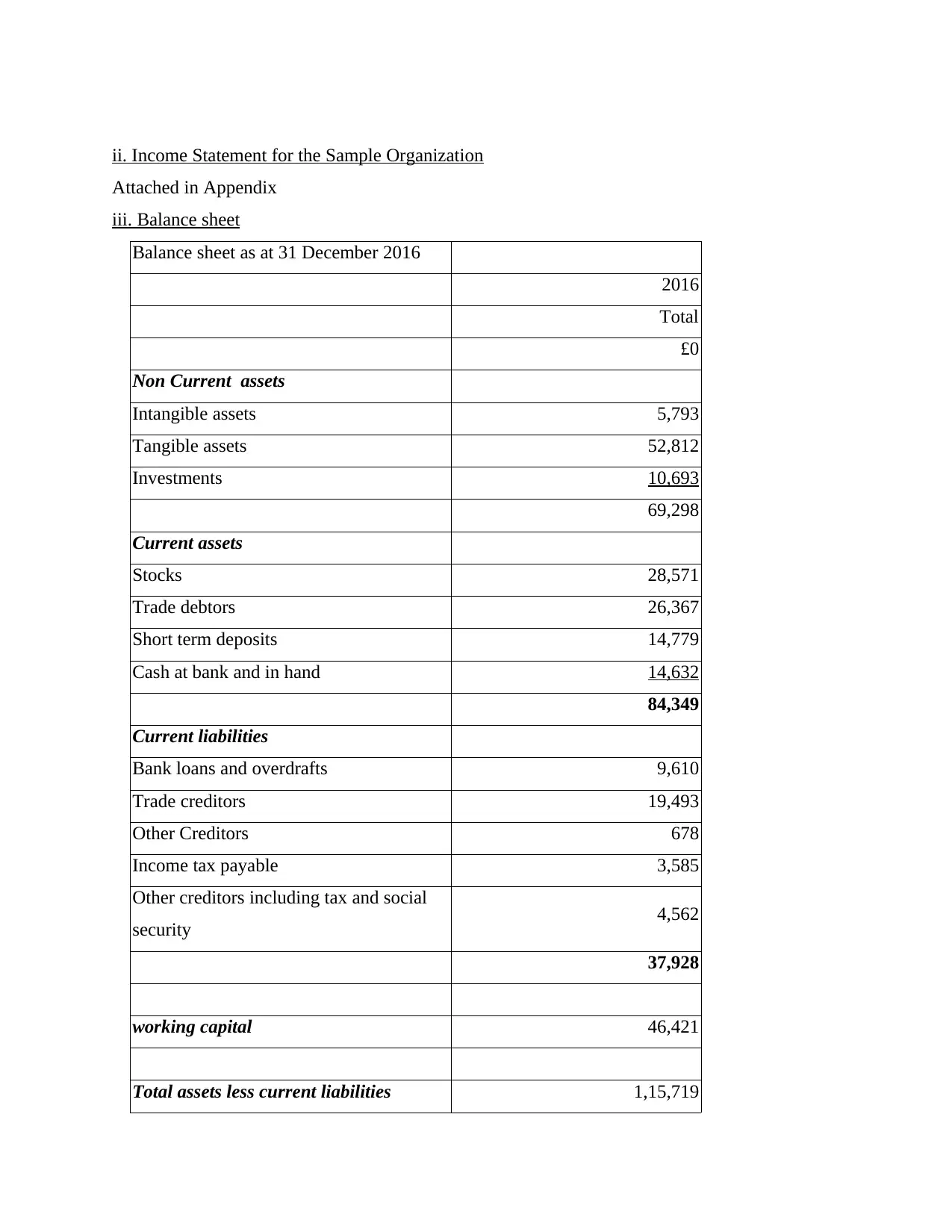
ii. Income Statement for the Sample Organization
Attached in Appendix
iii. Balance sheet
Balance sheet as at 31 December 2016
2016
Total
£0
Non Current assets
Intangible assets 5,793
Tangible assets 52,812
Investments 10,693
69,298
Current assets
Stocks 28,571
Trade debtors 26,367
Short term deposits 14,779
Cash at bank and in hand 14,632
84,349
Current liabilities
Bank loans and overdrafts 9,610
Trade creditors 19,493
Other Creditors 678
Income tax payable 3,585
Other creditors including tax and social
security 4,562
37,928
working capital 46,421
Total assets less current liabilities 1,15,719
Attached in Appendix
iii. Balance sheet
Balance sheet as at 31 December 2016
2016
Total
£0
Non Current assets
Intangible assets 5,793
Tangible assets 52,812
Investments 10,693
69,298
Current assets
Stocks 28,571
Trade debtors 26,367
Short term deposits 14,779
Cash at bank and in hand 14,632
84,349
Current liabilities
Bank loans and overdrafts 9,610
Trade creditors 19,493
Other Creditors 678
Income tax payable 3,585
Other creditors including tax and social
security 4,562
37,928
working capital 46,421
Total assets less current liabilities 1,15,719
Paraphrase This Document
Need a fresh take? Get an instant paraphrase of this document with our AI Paraphraser
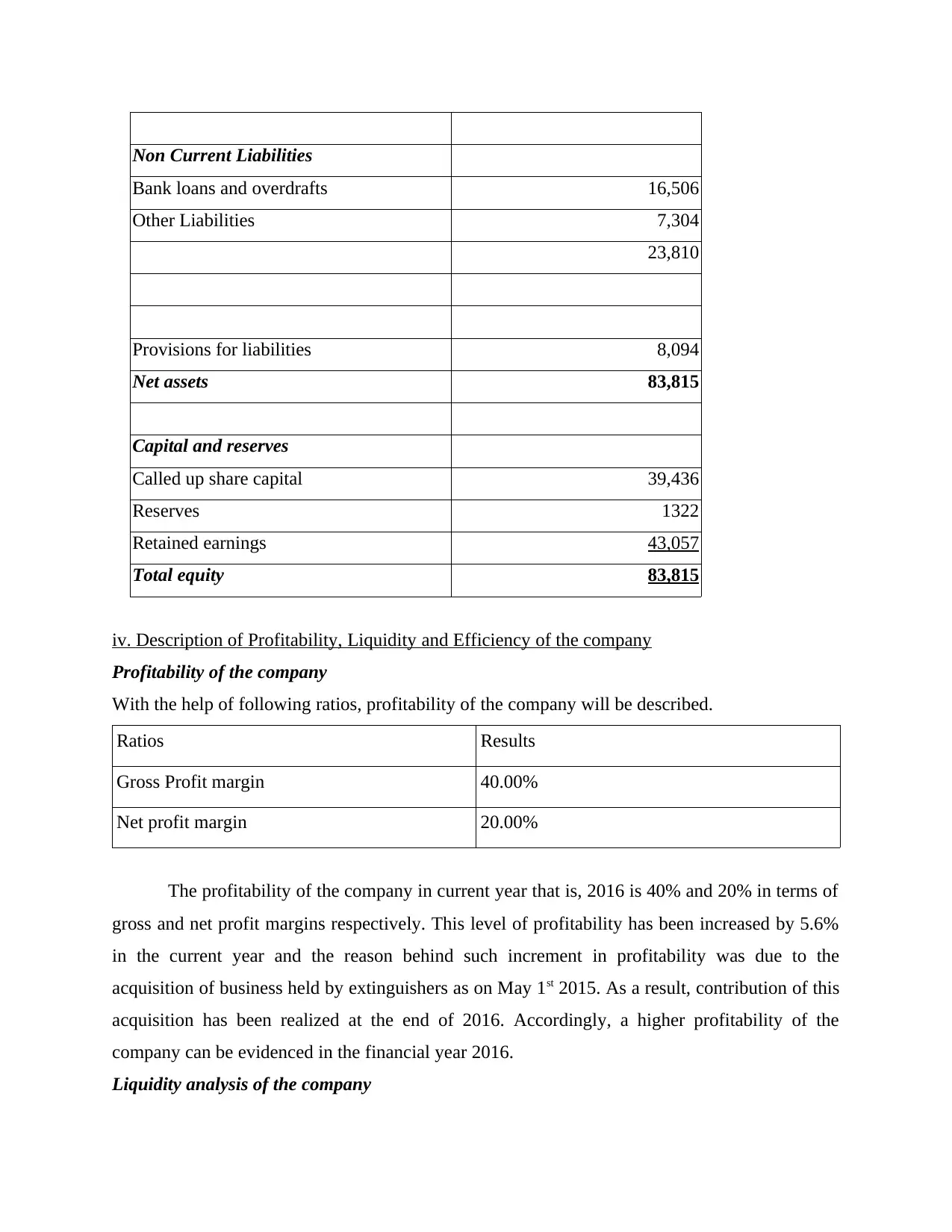
Non Current Liabilities
Bank loans and overdrafts 16,506
Other Liabilities 7,304
23,810
Provisions for liabilities 8,094
Net assets 83,815
Capital and reserves
Called up share capital 39,436
Reserves 1322
Retained earnings 43,057
Total equity 83,815
iv. Description of Profitability, Liquidity and Efficiency of the company
Profitability of the company
With the help of following ratios, profitability of the company will be described.
Ratios Results
Gross Profit margin 40.00%
Net profit margin 20.00%
The profitability of the company in current year that is, 2016 is 40% and 20% in terms of
gross and net profit margins respectively. This level of profitability has been increased by 5.6%
in the current year and the reason behind such increment in profitability was due to the
acquisition of business held by extinguishers as on May 1st 2015. As a result, contribution of this
acquisition has been realized at the end of 2016. Accordingly, a higher profitability of the
company can be evidenced in the financial year 2016.
Liquidity analysis of the company
Bank loans and overdrafts 16,506
Other Liabilities 7,304
23,810
Provisions for liabilities 8,094
Net assets 83,815
Capital and reserves
Called up share capital 39,436
Reserves 1322
Retained earnings 43,057
Total equity 83,815
iv. Description of Profitability, Liquidity and Efficiency of the company
Profitability of the company
With the help of following ratios, profitability of the company will be described.
Ratios Results
Gross Profit margin 40.00%
Net profit margin 20.00%
The profitability of the company in current year that is, 2016 is 40% and 20% in terms of
gross and net profit margins respectively. This level of profitability has been increased by 5.6%
in the current year and the reason behind such increment in profitability was due to the
acquisition of business held by extinguishers as on May 1st 2015. As a result, contribution of this
acquisition has been realized at the end of 2016. Accordingly, a higher profitability of the
company can be evidenced in the financial year 2016.
Liquidity analysis of the company
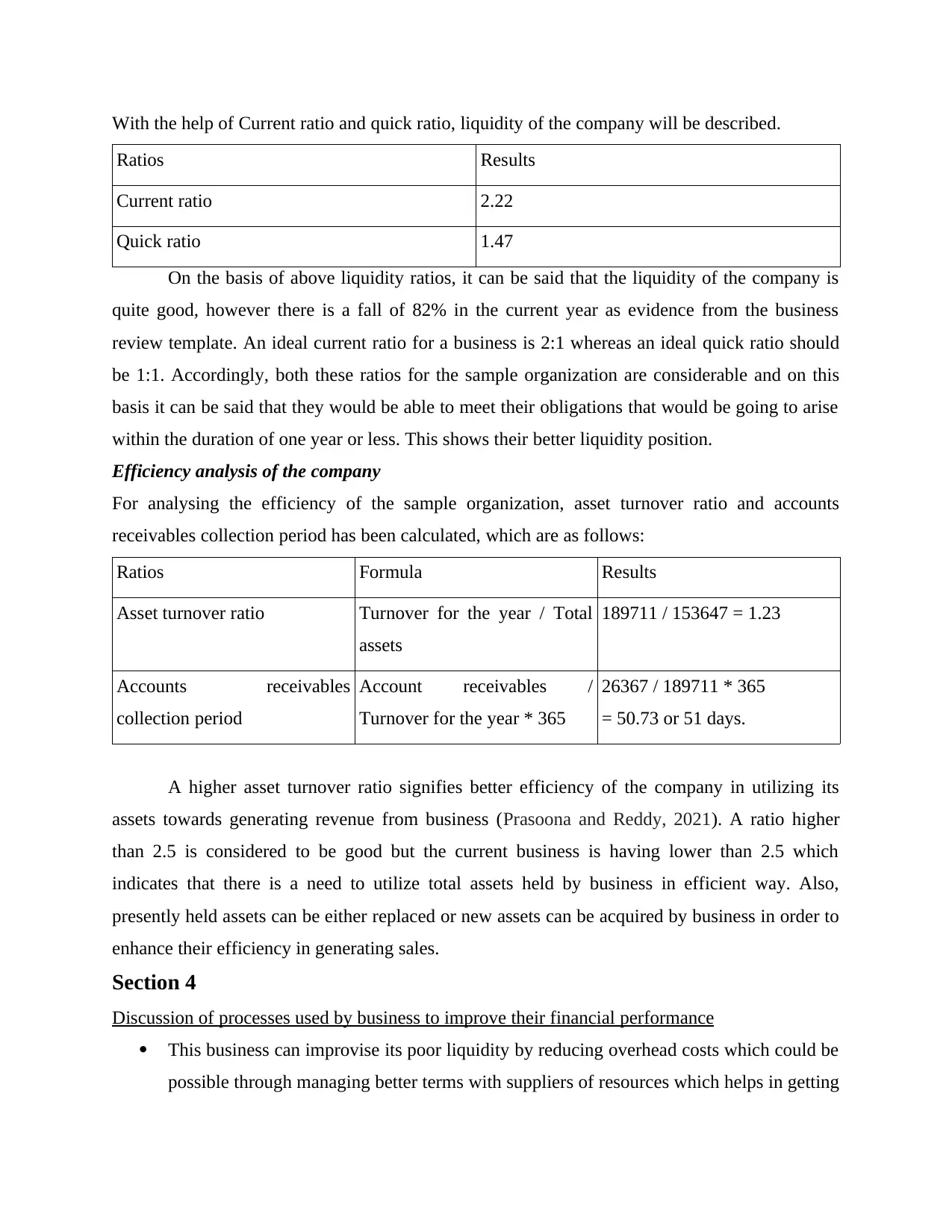
With the help of Current ratio and quick ratio, liquidity of the company will be described.
Ratios Results
Current ratio 2.22
Quick ratio 1.47
On the basis of above liquidity ratios, it can be said that the liquidity of the company is
quite good, however there is a fall of 82% in the current year as evidence from the business
review template. An ideal current ratio for a business is 2:1 whereas an ideal quick ratio should
be 1:1. Accordingly, both these ratios for the sample organization are considerable and on this
basis it can be said that they would be able to meet their obligations that would be going to arise
within the duration of one year or less. This shows their better liquidity position.
Efficiency analysis of the company
For analysing the efficiency of the sample organization, asset turnover ratio and accounts
receivables collection period has been calculated, which are as follows:
Ratios Formula Results
Asset turnover ratio Turnover for the year / Total
assets
189711 / 153647 = 1.23
Accounts receivables
collection period
Account receivables /
Turnover for the year * 365
26367 / 189711 * 365
= 50.73 or 51 days.
A higher asset turnover ratio signifies better efficiency of the company in utilizing its
assets towards generating revenue from business (Prasoona and Reddy, 2021). A ratio higher
than 2.5 is considered to be good but the current business is having lower than 2.5 which
indicates that there is a need to utilize total assets held by business in efficient way. Also,
presently held assets can be either replaced or new assets can be acquired by business in order to
enhance their efficiency in generating sales.
Section 4
Discussion of processes used by business to improve their financial performance
This business can improvise its poor liquidity by reducing overhead costs which could be
possible through managing better terms with suppliers of resources which helps in getting
Ratios Results
Current ratio 2.22
Quick ratio 1.47
On the basis of above liquidity ratios, it can be said that the liquidity of the company is
quite good, however there is a fall of 82% in the current year as evidence from the business
review template. An ideal current ratio for a business is 2:1 whereas an ideal quick ratio should
be 1:1. Accordingly, both these ratios for the sample organization are considerable and on this
basis it can be said that they would be able to meet their obligations that would be going to arise
within the duration of one year or less. This shows their better liquidity position.
Efficiency analysis of the company
For analysing the efficiency of the sample organization, asset turnover ratio and accounts
receivables collection period has been calculated, which are as follows:
Ratios Formula Results
Asset turnover ratio Turnover for the year / Total
assets
189711 / 153647 = 1.23
Accounts receivables
collection period
Account receivables /
Turnover for the year * 365
26367 / 189711 * 365
= 50.73 or 51 days.
A higher asset turnover ratio signifies better efficiency of the company in utilizing its
assets towards generating revenue from business (Prasoona and Reddy, 2021). A ratio higher
than 2.5 is considered to be good but the current business is having lower than 2.5 which
indicates that there is a need to utilize total assets held by business in efficient way. Also,
presently held assets can be either replaced or new assets can be acquired by business in order to
enhance their efficiency in generating sales.
Section 4
Discussion of processes used by business to improve their financial performance
This business can improvise its poor liquidity by reducing overhead costs which could be
possible through managing better terms with suppliers of resources which helps in getting
⊘ This is a preview!⊘
Do you want full access?
Subscribe today to unlock all pages.

Trusted by 1+ million students worldwide
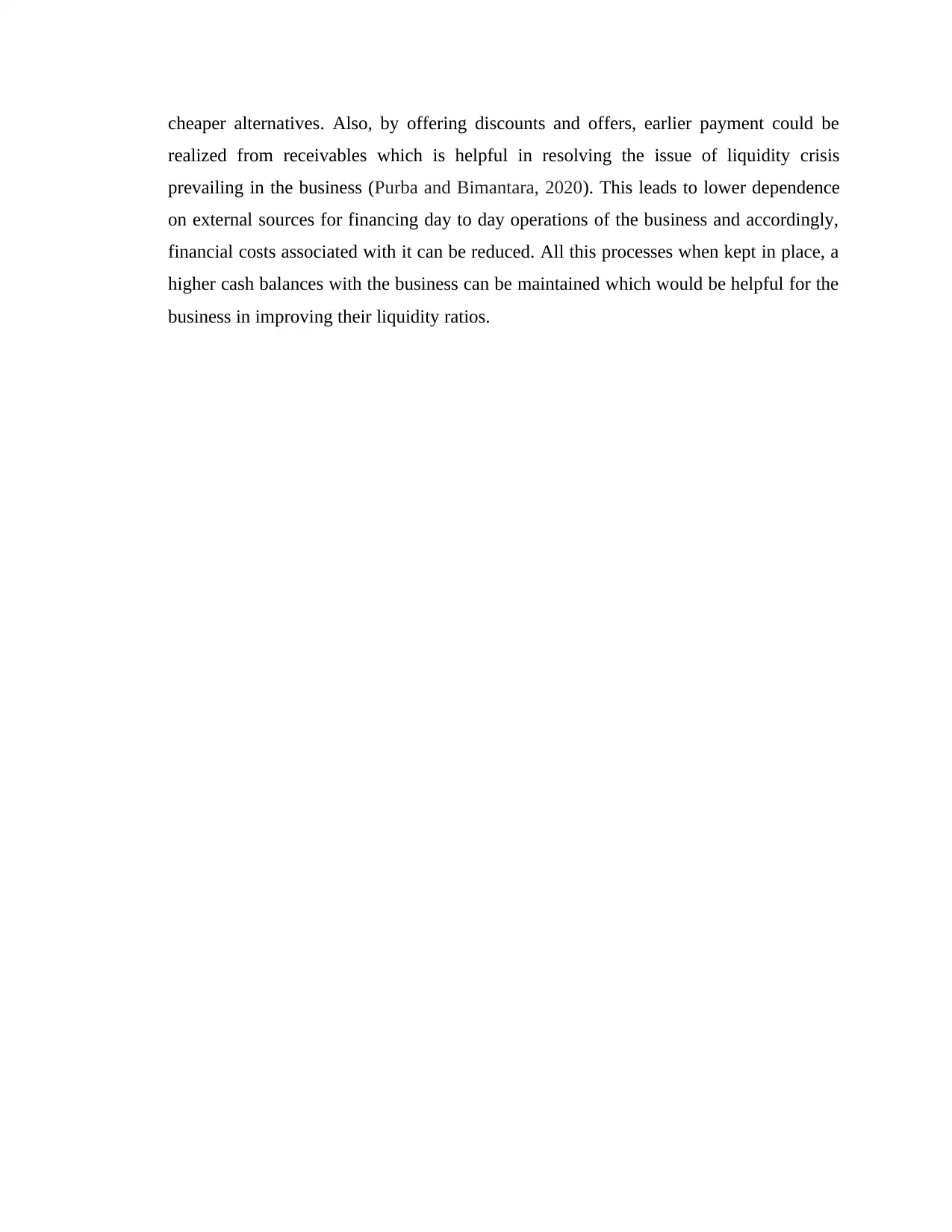
cheaper alternatives. Also, by offering discounts and offers, earlier payment could be
realized from receivables which is helpful in resolving the issue of liquidity crisis
prevailing in the business (Purba and Bimantara, 2020). This leads to lower dependence
on external sources for financing day to day operations of the business and accordingly,
financial costs associated with it can be reduced. All this processes when kept in place, a
higher cash balances with the business can be maintained which would be helpful for the
business in improving their liquidity ratios.
realized from receivables which is helpful in resolving the issue of liquidity crisis
prevailing in the business (Purba and Bimantara, 2020). This leads to lower dependence
on external sources for financing day to day operations of the business and accordingly,
financial costs associated with it can be reduced. All this processes when kept in place, a
higher cash balances with the business can be maintained which would be helpful for the
business in improving their liquidity ratios.
Paraphrase This Document
Need a fresh take? Get an instant paraphrase of this document with our AI Paraphraser
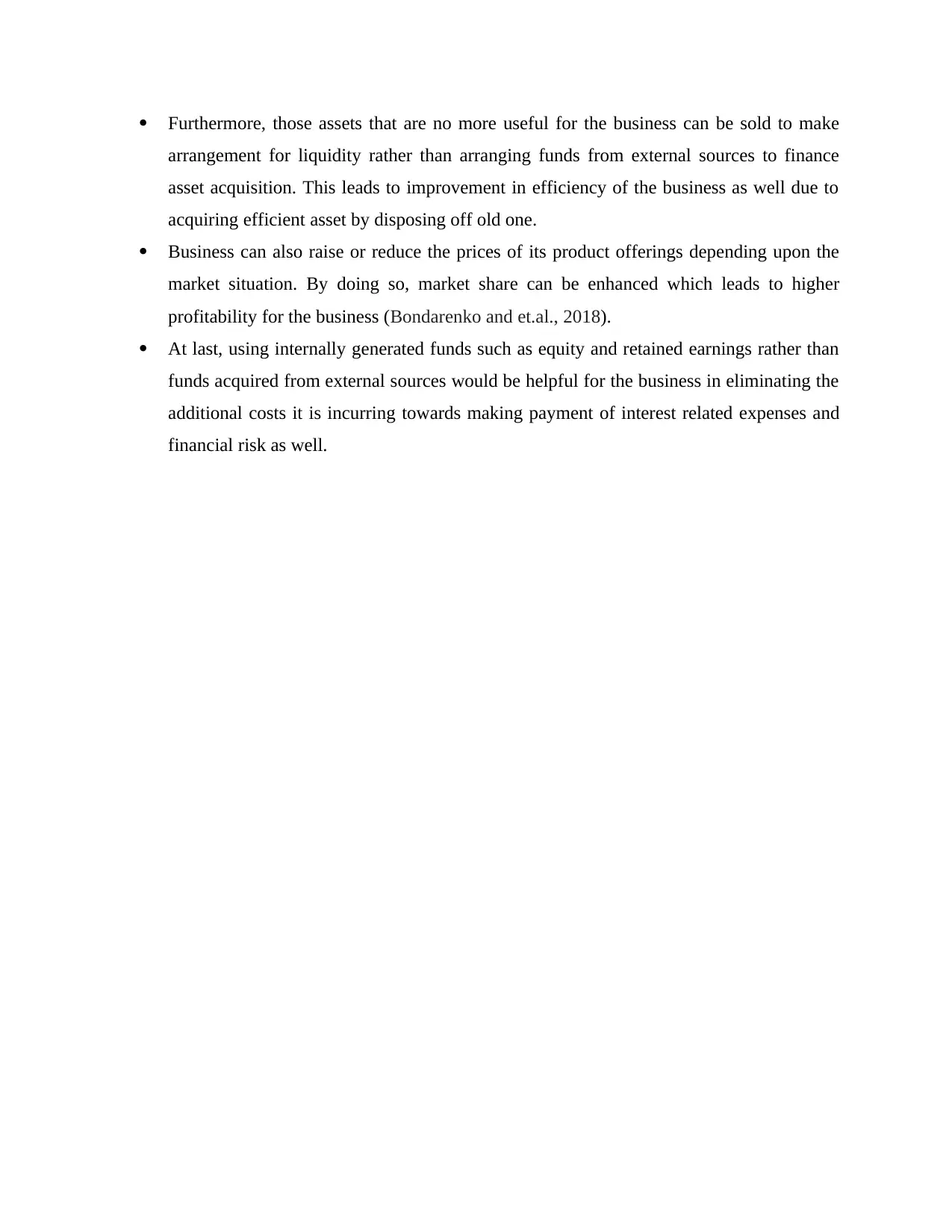
Furthermore, those assets that are no more useful for the business can be sold to make
arrangement for liquidity rather than arranging funds from external sources to finance
asset acquisition. This leads to improvement in efficiency of the business as well due to
acquiring efficient asset by disposing off old one.
Business can also raise or reduce the prices of its product offerings depending upon the
market situation. By doing so, market share can be enhanced which leads to higher
profitability for the business (Bondarenko and et.al., 2018).
At last, using internally generated funds such as equity and retained earnings rather than
funds acquired from external sources would be helpful for the business in eliminating the
additional costs it is incurring towards making payment of interest related expenses and
financial risk as well.
arrangement for liquidity rather than arranging funds from external sources to finance
asset acquisition. This leads to improvement in efficiency of the business as well due to
acquiring efficient asset by disposing off old one.
Business can also raise or reduce the prices of its product offerings depending upon the
market situation. By doing so, market share can be enhanced which leads to higher
profitability for the business (Bondarenko and et.al., 2018).
At last, using internally generated funds such as equity and retained earnings rather than
funds acquired from external sources would be helpful for the business in eliminating the
additional costs it is incurring towards making payment of interest related expenses and
financial risk as well.
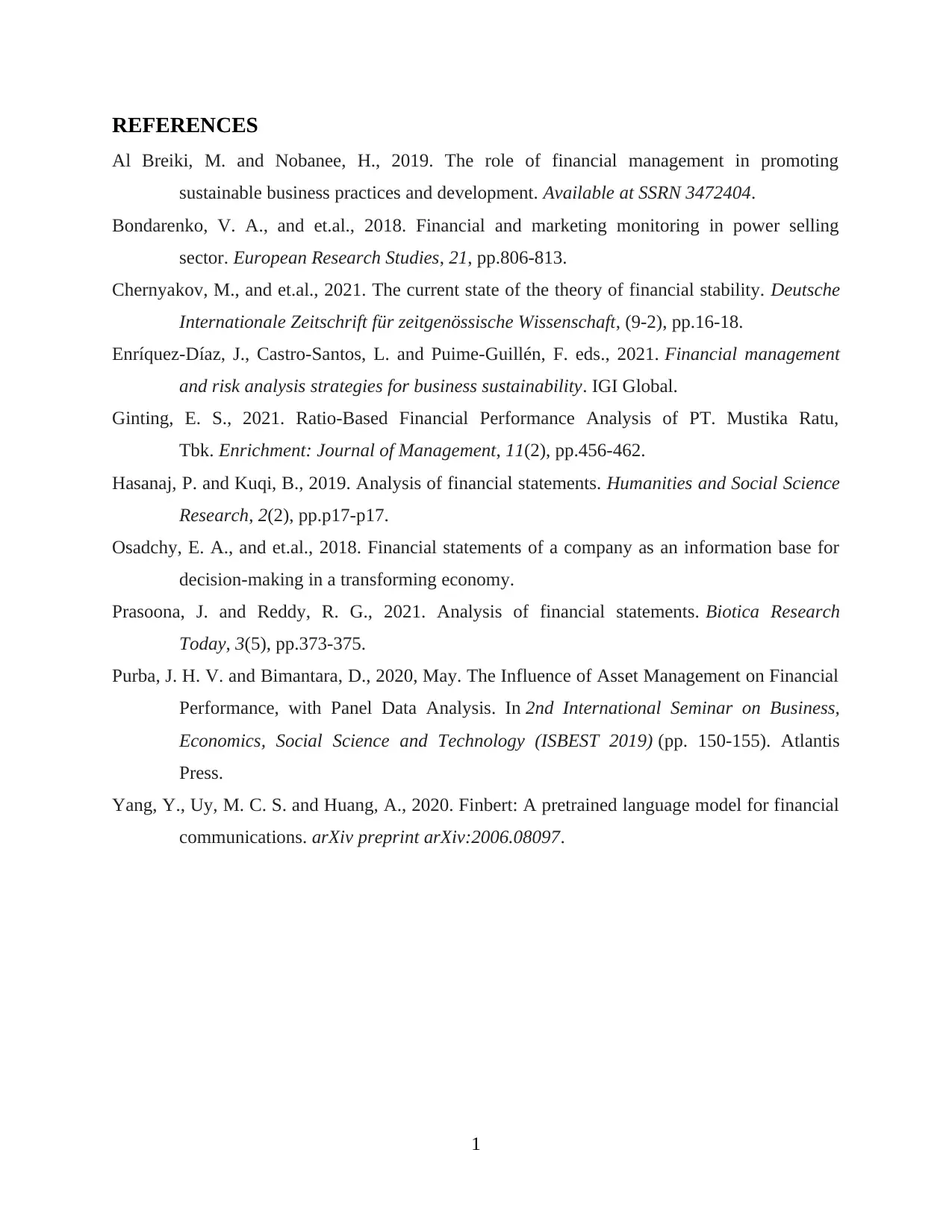
REFERENCES
Al Breiki, M. and Nobanee, H., 2019. The role of financial management in promoting
sustainable business practices and development. Available at SSRN 3472404.
Bondarenko, V. A., and et.al., 2018. Financial and marketing monitoring in power selling
sector. European Research Studies, 21, pp.806-813.
Chernyakov, M., and et.al., 2021. The current state of the theory of financial stability. Deutsche
Internationale Zeitschrift für zeitgenössische Wissenschaft, (9-2), pp.16-18.
Enríquez-Díaz, J., Castro-Santos, L. and Puime-Guillén, F. eds., 2021. Financial management
and risk analysis strategies for business sustainability. IGI Global.
Ginting, E. S., 2021. Ratio-Based Financial Performance Analysis of PT. Mustika Ratu,
Tbk. Enrichment: Journal of Management, 11(2), pp.456-462.
Hasanaj, P. and Kuqi, B., 2019. Analysis of financial statements. Humanities and Social Science
Research, 2(2), pp.p17-p17.
Osadchy, E. A., and et.al., 2018. Financial statements of a company as an information base for
decision-making in a transforming economy.
Prasoona, J. and Reddy, R. G., 2021. Analysis of financial statements. Biotica Research
Today, 3(5), pp.373-375.
Purba, J. H. V. and Bimantara, D., 2020, May. The Influence of Asset Management on Financial
Performance, with Panel Data Analysis. In 2nd International Seminar on Business,
Economics, Social Science and Technology (ISBEST 2019) (pp. 150-155). Atlantis
Press.
Yang, Y., Uy, M. C. S. and Huang, A., 2020. Finbert: A pretrained language model for financial
communications. arXiv preprint arXiv:2006.08097.
1
Al Breiki, M. and Nobanee, H., 2019. The role of financial management in promoting
sustainable business practices and development. Available at SSRN 3472404.
Bondarenko, V. A., and et.al., 2018. Financial and marketing monitoring in power selling
sector. European Research Studies, 21, pp.806-813.
Chernyakov, M., and et.al., 2021. The current state of the theory of financial stability. Deutsche
Internationale Zeitschrift für zeitgenössische Wissenschaft, (9-2), pp.16-18.
Enríquez-Díaz, J., Castro-Santos, L. and Puime-Guillén, F. eds., 2021. Financial management
and risk analysis strategies for business sustainability. IGI Global.
Ginting, E. S., 2021. Ratio-Based Financial Performance Analysis of PT. Mustika Ratu,
Tbk. Enrichment: Journal of Management, 11(2), pp.456-462.
Hasanaj, P. and Kuqi, B., 2019. Analysis of financial statements. Humanities and Social Science
Research, 2(2), pp.p17-p17.
Osadchy, E. A., and et.al., 2018. Financial statements of a company as an information base for
decision-making in a transforming economy.
Prasoona, J. and Reddy, R. G., 2021. Analysis of financial statements. Biotica Research
Today, 3(5), pp.373-375.
Purba, J. H. V. and Bimantara, D., 2020, May. The Influence of Asset Management on Financial
Performance, with Panel Data Analysis. In 2nd International Seminar on Business,
Economics, Social Science and Technology (ISBEST 2019) (pp. 150-155). Atlantis
Press.
Yang, Y., Uy, M. C. S. and Huang, A., 2020. Finbert: A pretrained language model for financial
communications. arXiv preprint arXiv:2006.08097.
1
⊘ This is a preview!⊘
Do you want full access?
Subscribe today to unlock all pages.

Trusted by 1+ million students worldwide
1 out of 12
Related Documents
Your All-in-One AI-Powered Toolkit for Academic Success.
+13062052269
info@desklib.com
Available 24*7 on WhatsApp / Email
![[object Object]](/_next/static/media/star-bottom.7253800d.svg)
Unlock your academic potential
Copyright © 2020–2025 A2Z Services. All Rights Reserved. Developed and managed by ZUCOL.


